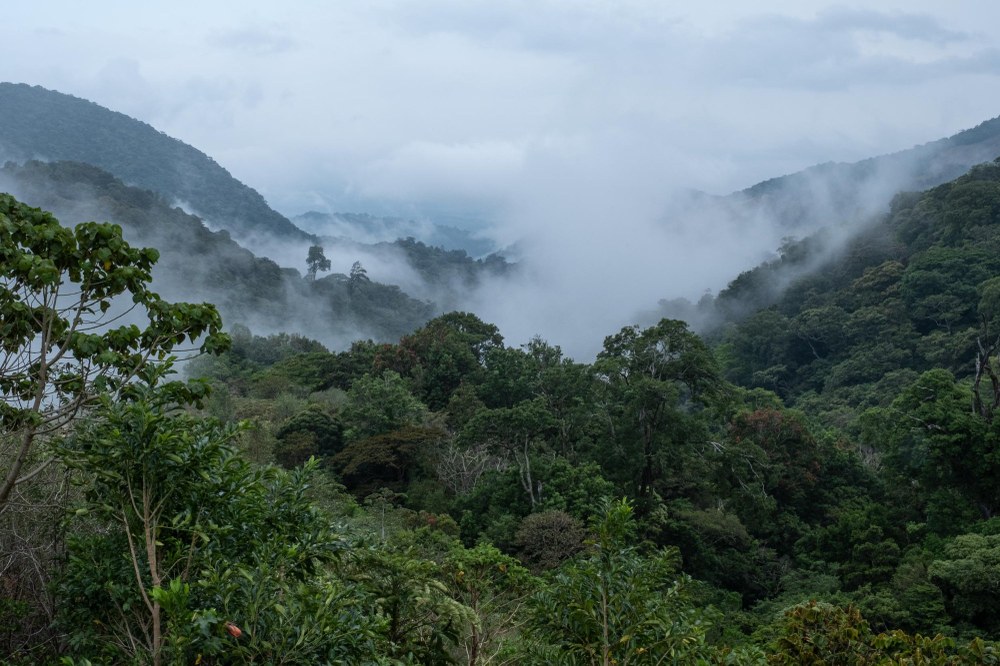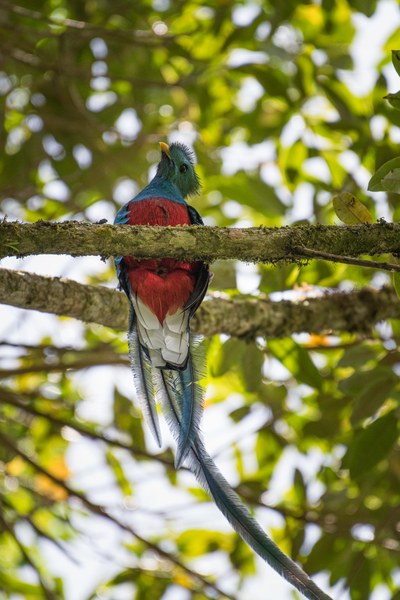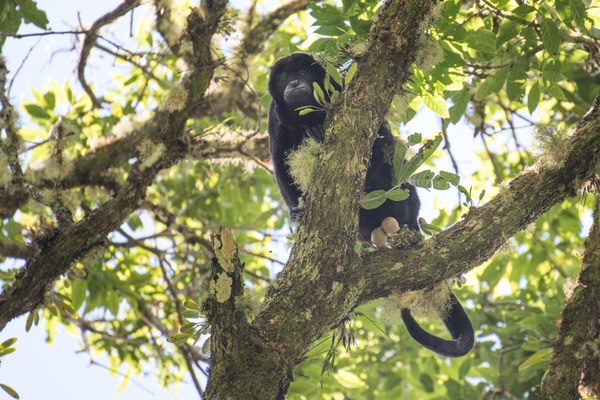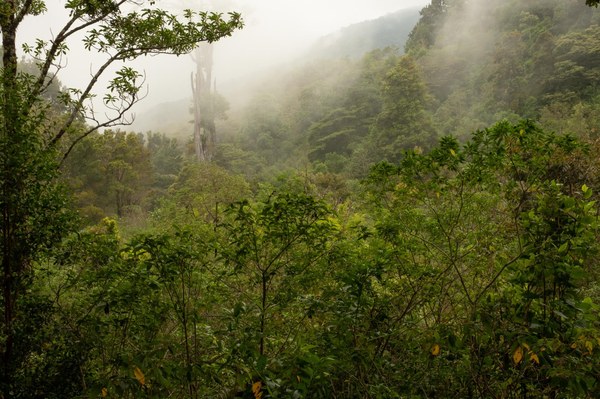
Keow-kowee keow k’loo keow k’loo keeloo came from right over our heads, making us stop abruptly. Jeffrey, my hiking companion, whispered, "Quetzal, courtship." My head was already crunched all the way back so I could stare directly into the canopy of this tropical forest. Resplendent Quetzals were in courtship. The male flew from one branch to another, his long tail waving behind him; the female also was moving back and forth, twigs swaying with her activity. My parabolic reflector pointed right at them, I was capturing their courtship on my sound recorder.

This was the sixth of eight days in the mountains of Western Panama, up close to the Costa Rican border. Just that morning, we had left Mt. Totumas Lodge an hour before sunrise to hike up the Rio Colorado Valley so that we could listen to the dawn chorus by a grande aguacate tree. Howler monkeys greeted the first hint of light, followed by a plethora of birds. An hour later, as we packed our gear for the walk back, a Collared Forest-Falcon called, telling us how great the day was.
 A fluttering of wings disappearing up the hillside indicated that the quetzals had flown, but at least six Swainson’s Thrushes were giving their whit calls (listen to them yourself here). These thrushes were probably the most common bird seen and heard during my April trip. They use Panama as a waypoint on their northward migration from wintering in South America to their breeding grounds. Other migrants, familiar from the United States, had been here, too. Wilson and Tennessee warblers, Scarlet and Summer tanagers, Rose-breasted Grosbeaks, and the acrobatic Swallow-tailed Kites had all shown themselves. But the Neotropical birds captured the imagination and left me mesmerized. Ten species of hummingbirds, tinamous, guans, a plethora of flycatchers, wrens, redstarts, tropical thrushes, and so many more. My thoughts were interrupted by the screeching of a Three-wattled Bellbird as if it wanted to make sure I didn’t forget about him. Their far-carrying bell-like note and strange metallic screech had filled the forest each day.
A fluttering of wings disappearing up the hillside indicated that the quetzals had flown, but at least six Swainson’s Thrushes were giving their whit calls (listen to them yourself here). These thrushes were probably the most common bird seen and heard during my April trip. They use Panama as a waypoint on their northward migration from wintering in South America to their breeding grounds. Other migrants, familiar from the United States, had been here, too. Wilson and Tennessee warblers, Scarlet and Summer tanagers, Rose-breasted Grosbeaks, and the acrobatic Swallow-tailed Kites had all shown themselves. But the Neotropical birds captured the imagination and left me mesmerized. Ten species of hummingbirds, tinamous, guans, a plethora of flycatchers, wrens, redstarts, tropical thrushes, and so many more. My thoughts were interrupted by the screeching of a Three-wattled Bellbird as if it wanted to make sure I didn’t forget about him. Their far-carrying bell-like note and strange metallic screech had filled the forest each day.
 Jeffrey tipped his head to ask if I was ready to continue. I nodded. The network of trails here had been outstanding. Each day we’d explored a different area. Jeffrey went with me on that day, but on most days, Reinaldo had accompanied me. This young man was a remarkable birder. He knew all the local calls and could imitate thirty or more bird species. But most fantastic was his ability to spot things in this thick jungle and then show them to me. Twice we took bag lunches and hiked deep into this magical place. Other days we came back to the lodge for a late lunch, and I spent the afternoon watching hummingbirds or exploring on my own. One day we climbed Mt. Totumas itself, an extinct cinder cone that rises above these forests. The top was covered with gigantic Costa Rican oaks and had the lushest community of epiphytes I'd ever seen.
Jeffrey tipped his head to ask if I was ready to continue. I nodded. The network of trails here had been outstanding. Each day we’d explored a different area. Jeffrey went with me on that day, but on most days, Reinaldo had accompanied me. This young man was a remarkable birder. He knew all the local calls and could imitate thirty or more bird species. But most fantastic was his ability to spot things in this thick jungle and then show them to me. Twice we took bag lunches and hiked deep into this magical place. Other days we came back to the lodge for a late lunch, and I spent the afternoon watching hummingbirds or exploring on my own. One day we climbed Mt. Totumas itself, an extinct cinder cone that rises above these forests. The top was covered with gigantic Costa Rican oaks and had the lushest community of epiphytes I'd ever seen.
As I followed Jeffrey over a little knoll on that early morning, the red roof of the lodge came into view and made me think that this place would be great to visit again.
In 2019, I returned for my third visit to Mt. Totumas; this time with five friends from The Mountaineers. In 2020, I will go yet again with a Global Adventures group. And in the meantime, join us for a presentation on October 23 at the Seattle Program Center for a birding and naturalist tour of this magnificent part of the world. I will also cover planning for a remote trip, photographic techniques, and will have sound recordings from Panama.

 Thomas Bancroft
Thomas Bancroft